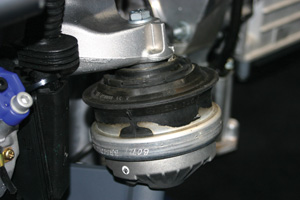For many years, automakers relied on solid rubber motor mounts to support the engine. The natural flexibility in rubber allows the mounts to absorb vibration. But if the rubber is too compliant, the engine may experience excessive motion under load that could stress and crack exhaust pipes and connections. And with such tight clearances under the hood, there’s a risk of something rubbing against something else and causing additional noise or problems. So, the rubber in the mounts has to be relatively stiff to limit compliance so the engine does not rock excessively when it is under load.
 Engine vibration is usually most noticeable when the engine is idling, especially if the engine has an odd fire configuration as some V6 engines do. Four-cylinder engines, as well as diesels, can also produce a lot of vibration at idle. Vibrations can be amplified even more when high-load belt-driven accessories, such as the A/C compressor, are engaged while the engine is idling.
Engine vibration is usually most noticeable when the engine is idling, especially if the engine has an odd fire configuration as some V6 engines do. Four-cylinder engines, as well as diesels, can also produce a lot of vibration at idle. Vibrations can be amplified even more when high-load belt-driven accessories, such as the A/C compressor, are engaged while the engine is idling.
HYDROMOUNTS
A little more than 30 years ago, the automakers came up with a solution for reducing NVH. It was the glycol-filled “hydromount.” Replacing solid rubber motor mounts with ones made of hollow rubber filled with fluid allowed the mounts to absorb more vibration without allowing excessive engine motion. It was a totally passive design that did not require any other modifications.
Hydromounts began appearing on various vehicles in the 1980s, and by the 1990s they were common on many domestic and import vehicles. The mounts were more expensive to manufacture (and replace) than solid mounts, and over time they tended to crack and lose their fluid. A hydromount that has lost its fluid is somewhat like a jelly-filled donut that has lost its filling. It goes flat and can no longer provide the same degree of NVH dampening as it once did. The mount has reached the end of the road and needs to be replaced.
Obviously, the only way to restore the same level of NVH control is to replace bad hydromounts that have lost their fluid with new hydromounts. However, a less expensive alternative is to replace the original hydromounts with aftermarket solid mounts. The cost-savings of solid mounts will likely appeal to many customers, but they need to be warned that the stiffer solid mounts won’t provide the same degree of NVH as hydromounts. The driver will likely feel more engine vibration at idle — which may or may not be an issue depending on the driver.
In some cases, the original hydromounts (whether they are still good or not) may be replaced with solid motor mounts to stiffen things up. This would be the case with a street performance or racing application where increased engine torque has to be controlled with stronger, stiffer motor mounts.
ACTIVE MOUNTS
It was inevitable that sooner or later, dumb motor mounts would get smart. A “tunable” motor mount that can change its dampening characteristics has a significant NVH advantage over a passive hydromount or a solid mount. Such a mount can be relatively soft at idle to absorb the unwanted shakes produced by widely or unevenly spaced cylinder firings, then stiffen up at higher engine speeds and loads to limit unwanted engine motions. It’s the best of both worlds, but it does require some type of external controls and inputs. These mounts are found on a number of late model vehicles including Honda, Hyundai, Jaguar, Lexus, Toyota and others.
On 2005 to 2008 Toyota Camry V6 models, for example, a vacuum-actuated “Active Control Engine Mount (ACM) system is used to reduce NVH. The front engine mount has a hollow chamber inside that allows the stiffness of the mount to change when vacuum is applied. A duty cycle Vacuum Switching Valve (VSV) on the outside of the mount is controlled by the powertrain control module. When the engine is idling, the PCM completes the ground circuit to the VSV solenoid, allowing intake vacuum to be applied to the mount. This makes the mount more compliant and allows it to absorb more vibration and shake. At higher engine speeds, the PCM reduces the frequency of the pulse signal to the VSV to gradually increase the stiffness of the mount to match engine speed.
On the Toyota application (which is similar to the active mount systems that Honda and Hyundai use), power to the VSV control valve is routed through the fuel injection relay. Vacuum is routed to the active mount through a pair of hoses connected to the engine’s vacuum reservoir.
On this system, a noticeable increase in NVH can occur if the active mount leaks vacuum, if the hose connections leak vacuum (or are obstructed), or if there is a problem with the VSV control valve, wiring harness or PCM.
The motor mount can be diagnosed with a handheld vacuum pump to see if it holds vacuum or not. If it leaks, it needs to be replaced. You can also use the vacuum pump gauge or your finger to see if vacuum is reaching the VSV control valve when the engine is idling. No vacuum or weak vacuum would tell you there’s a leak in the plumbing somewhere.













